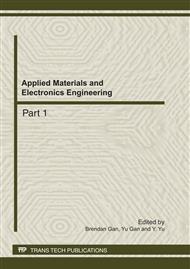p.711
p.715
p.719
p.723
p.727
p.731
p.735
p.740
p.744
Fabrication Optimization of Magnesium Az61 Alloys via Extrusion for High Productivity
Abstract:
The nature of high specific strength compared with other structural materials has led to wide application of Mg alloys. However, Mg alloys often exhibit relatively low strength and/or low surface stability, which can limit the practical application of the alloy system. In order to achieve high strength, the commercial AZ61 alloys were extruded, so that the application of the alloy system can be extended towards new structural parts for requiring the light nature of the alloy system. In this study, a high temperature extrusion has been carried out for the commercial Mg alloys (AZ61). The productivity and mechanical properties of the alloy were critically affected by the extrusion conditions such as temperature, extrusion ratio and extrusion speed. The texture development and alloy strengths with respect to the extrusion conditions have been discussed in terms of microstructural observations and phase analyses.
Info:
Periodical:
Pages:
727-730
Citation:
Online since:
October 2011
Keywords:
Price:
Сopyright:
© 2012 Trans Tech Publications Ltd. All Rights Reserved
Share:
Citation:


